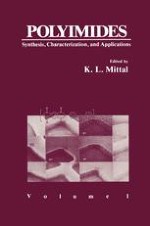1984 | Buch
Über dieses Buch
This and its companion Volume 2 chronicle the proceedings of the First Technical Conference on Polyimides: Synthesis, Char acterization and Applications held under the auspices of the Mid Hudson Section of the Society of Plastics Engineers at Ellenville, New York, November 10-12, 1982. In the last decade or so there has been an accelerated interest in the use of polyimides for a variety of applications in a number of widely differing technologies. The applications of polyimides range from aerospace to microelectronics to medical field, and this is attributed to the fact that polyimides offer certain desirable traits, inter alia, high temperature stability. Polyimides are used as organic insulators, as adhesives, as coat ings, in composites, just to name a few of their uses. Even a casual search of the literature will underscore the importance of this class of materials and the high tempo of R&D activity taking place in the area of polyimides. So it was deemed that a conference on polyimides was both timely and needed. This conference was designed to provide a forum for discussion of various ramifications of polyimides, to bring together scientists and technologists interested in all aspects of polyimides and thus to provide an opportunity for cross-pollination of ideas, and to highlight areas which needed further and intensi fied R&D efforts. If the comments from the attendees are a baro meter of the success of a conference, then this event was highly successful and fulfilled amply its stated objectives.
Anzeige
